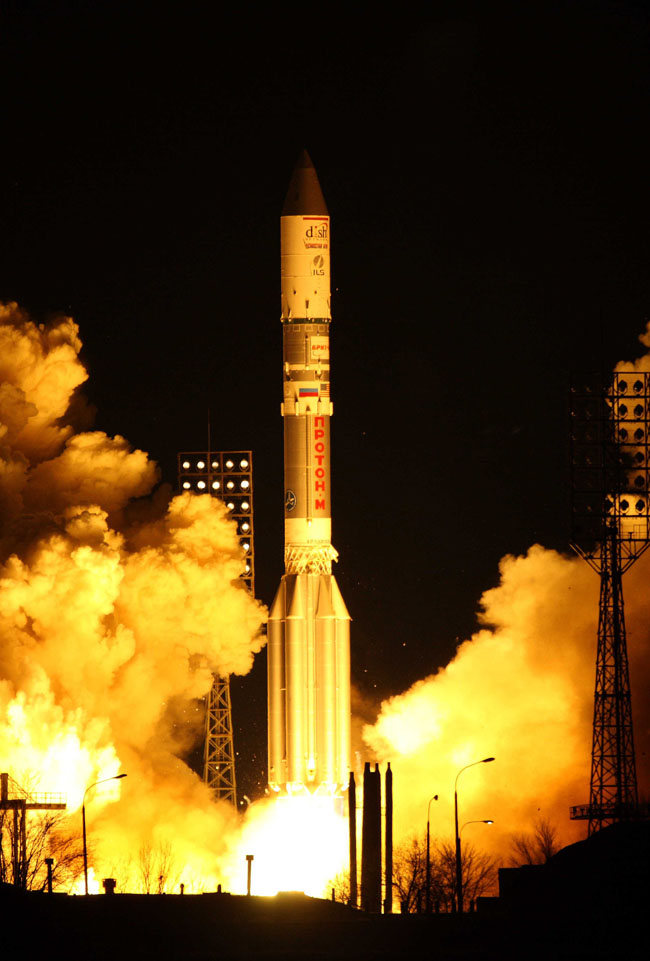Proton Rocket Launches New DISH Network Satellite

A new direct broadcasting satellite for DISH Network waslaunched into orbit Saturday by a Proton rocket, beginning a 15-year mission toexpand the service's high definition programming across the United States.
Once operational, EchoStar 14 will reachmore than 14 million DISH Network subscribers across the United States,including Alaska, Hawaii and Puerto Rico. The spacecraft weighed 14,074 poundsat launch, near the peak capacity of the heavy-lift Protonrocket and the Breeze M upper stage.
International Launch Services officials say upgrades byRussian rocket-builder Khrunichev have increased the Proton's liftcapabilities, allowing heavier satellites like EchoStar 14 to be launched bythe booster. EchoStar 14 is the heaviest commercial satellite ever launched ona Proton rocket.
ILS is the U.S.-based firm responsible for selling Protonlaunches on the commercial marketplace.
"We want the satellite to be designed to last at least15 years," said Dean Olmstead, president of EchoStar Satellite Services ofEnglewood, Colo. "They have a launch vehicle that can launch a payloadcontaining a greater fuel load that ensures that 15-year life span."
The satellite will expand DISH Network's high definitiontelevision services and flexibility for the company's subscribers. EchoStar 14will double the communications power of earlier EchoStar satellites, accordingto Olmstead.
"The satellite can help decrease rain fade issues incertain areas of the country," Olmstead said. "DISH Network can offerlocal channels in standard definition and high definition. The satelliteincreases fleet redundancy by adding capacity to offer backup services for theother satellites."
Get the Space.com Newsletter
Breaking space news, the latest updates on rocket launches, skywatching events and more!
EchoStar Satellite Services manages satellite acquisition,construction, launch services, testing and operations for DISH Network.
The Proton rocket and EchoStar 14 blastedoff from the Baikonur Cosmodrome in Kazakhstan at 1826:57 GMT (2:26:57 p.m.EDT). It was just after midnight at the launch site in Central Asia.
The shining silver booster rocketed into clear skies,accelerating past the speed of sound about a minute after liftoff. Two minutesinto the flight, the 191-foot-tall rocket shed its six-engine first stage asthe Proton's second stage engines took over.
The Proton's three core stages propelled EchoStar 14 into aparabolic suborbital trajectory, and the Breeze M upper stage separated fromthe Proton vehicle at T+9 minutes, 42 seconds.
The Breeze M ignited its main engine for nearlyfour-and-a-half minutes to deliver EchoStar 14 into a low-altitude parkingorbit about 16 minutes after liftoff, according to ILS.
The Breeze M fired four more times to gradually pushEchoStar 14 to higher altitudes. The rocket was targeting a geosynchronoustransfer orbit with a high point of 22,236 miles, a low point of 1,939 milesand an inclination of 26.7 degrees.
The upper stage deployed EchoStar 14 on time at about 0337GMT Sunday (11:37 p.m. EDT Saturday) to complete the launch, according tostatements by Khrunichev and ILS.
"Everything occurred as planned with ignition, shutdownand separation of the Proton's first three stages," said an update on theILS Web site. "Then the Breeze M upper stage with the satellite continuedthe mission, igniting five times, and then releasing the satellite into [the]transfer orbit."
EchoStar 14's own propulsion system will nudge thespacecraft higher in the coming weeks, eventually reaching a circular orbitabout 22,300 miles high over the equator.
"On behalf of our customer, DISH Network, we arepleased with the performance of the launch vehicle and look forward to testingof the satellite," said Rohan Zaveri, vice president of space programs forEchoStar.
After checks to verify the satellite is functioningproperly, EchoStar 14 will enter service parked at 119 degrees west longitude.It will replace the EchoStar 7 satellite launched on an Atlas rocket inFebruary 2002.
Designed to last up to 15 years, EchoStar 14 carries 103Ku-band transponders that will reach customers across North America.
The satellite's manufacturer is Space Systems/Loralheadquartered in Palo Alto, Calif. EchoStar 14 is based on the company'sLS-1300 platform.
"Appropriately, we're launching on the spring equinox,"said Jeremy Egolf, Space System/Loral's launch vehicle mission manager forEchoStar 14. "Spring is a time of new beginnings."
Another commercial Proton launch is scheduled for April 24with the SES 1 communications satellite.
- Cluster Satellites Dance In Orbit - And In Video
- Images - 20 Great Rocket Launches
- How Amateur Sleuths Spot Satellites

Join our Space Forums to keep talking space on the latest missions, night sky and more! And if you have a news tip, correction or comment, let us know at: community@space.com.
Stephen Clark is the Editor of Spaceflight Now, a web-based publication dedicated to covering rocket launches, human spaceflight and exploration. He joined the Spaceflight Now team in 2009 and previously wrote as a senior reporter with the Daily Texan. You can follow Stephen's latest project at SpaceflightNow.com and on Twitter.









